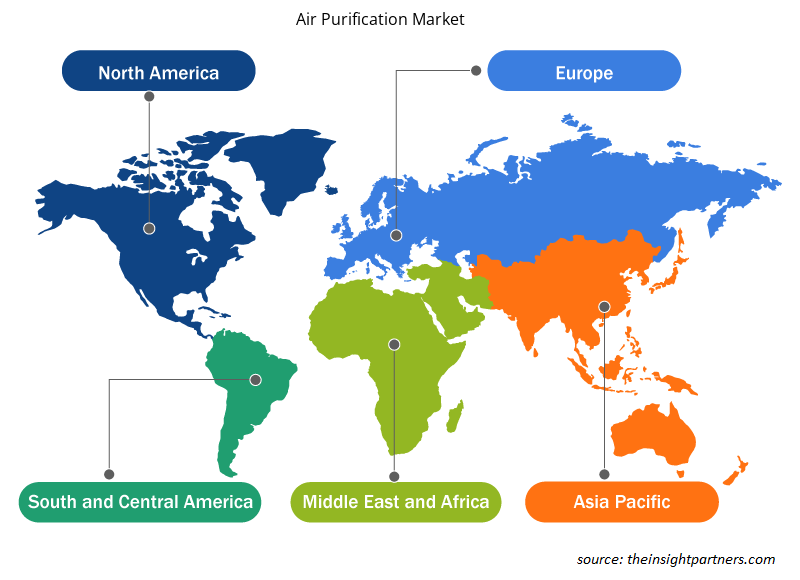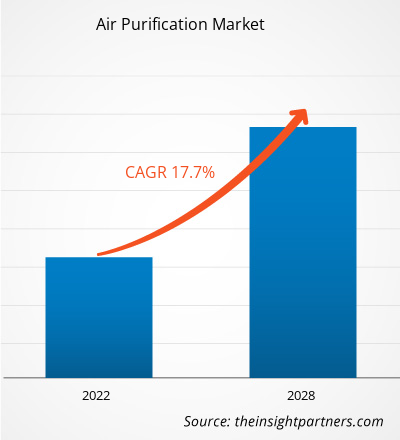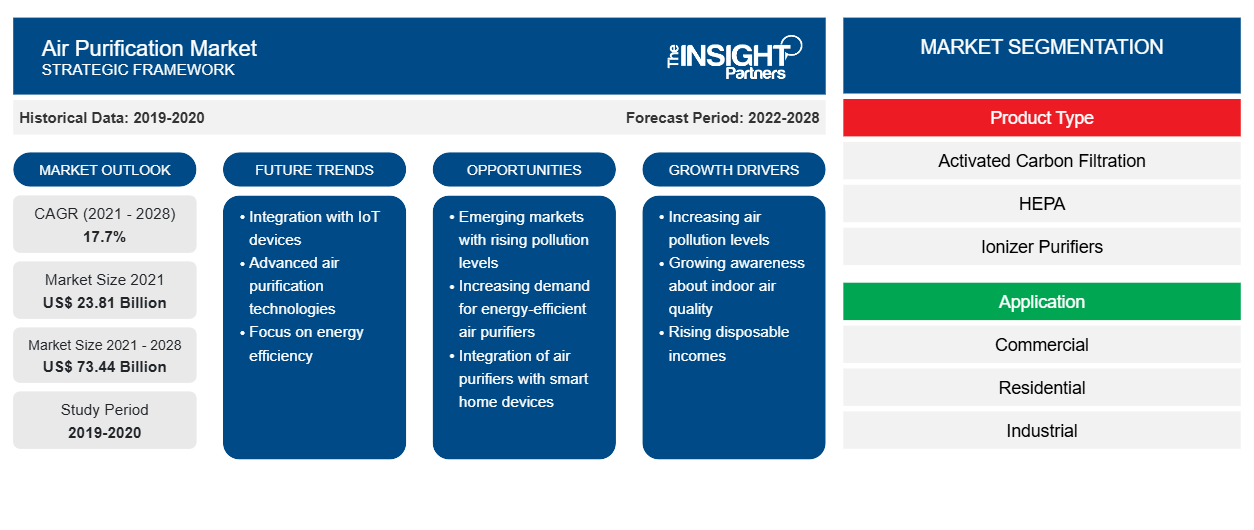Der Markt für Luftreinigung wird voraussichtlich von 23.809,52 Millionen US-Dollar im Jahr 2021 auf 73.437,36 Millionen US-Dollar im Jahr 2028 wachsen. Von 2021 bis 2028 wird mit einer durchschnittlichen jährlichen Wachstumsrate von 17,7 % gerechnet.
Der Anstieg luftübertragener Krankheiten aufgrund der zunehmenden Luftverschmutzung ist ein Schlüsselfaktor für das Wachstum des Marktes. Darüber hinaus sind das wachsende Bewusstsein der Verbraucher für den Einsatz von Luftreinigern, ein Anstieg des verfügbaren Einkommens und ein verbesserter Lebensstandard die wichtigsten Faktoren, die das Marktwachstum ankurbeln. Der wachsende Trend zur Einführung tragbarer und intelligenter Luftreiniger treibt die Marktdynamik im Prognosezeitraum weiter voran. Die unterstützenden Regierungsinitiativen in Bezug auf Emissionsstandards, die Durchsetzung von Gesundheits- und Sicherheitsvorschriften für Arbeitnehmer und die Änderung bestehender Luftreinheitsrichtlinien stärken die Marktdynamik für den Luftreinigungsmarkt weiter . So hatte Indien im August 2021 geplant, die neuen nationalen Luftqualitätsstandards (NAAQS) im Jahr 2022 wieder einzuführen.
Die neuen Standards umfassen ultrafeine Partikelbestandteile, die unter PM2,5 liegen. Außerdem hat die Weltgesundheitsorganisation (WHO) im September 2021 neue globale Luftqualitätsrichtlinien (AQGs) eingeführt, um die Gesundheit der Bevölkerung zu schützen, indem die Konzentration wichtiger Luftschadstoffe, die zum Klimawandel beitragen, reduziert wird. Daher erhöhen solche Initiativen den Bedarf an Luftreinigungsprodukten weiter und beeinflussen die Marktaussichten im Prognosezeitraum.
Die weltweite Nachfrage nach tragbaren Luftfiltern ist ein wichtiger Trend, der den Markt wachsen lässt. Veränderungen im Lebensstil wirken sich direkt auf die Gesundheit der Menschen aus und erhöhen den Bedarf an Luftreinigungsprodukten. Tragbare Luftreiniger verwenden einen HEPA-13-Filter, einen Kohlefilter und eine antimikrobielle Beschichtung auf den Filtern, um Bakterienwachstum zu verhindern. Diese Filter sind sehr effektiv und werden immer häufiger verwendet. Der steigende Verschmutzungsgrad und die zunehmende Zahl von durch die Luft übertragenen Krankheiten haben die Nachfrage nach tragbaren Luftfiltern beschleunigt. Die Studie der Forscher der Simon Fraser University zeigt, dass ein tragbarer Luftreiniger im Haushalt die negativen Auswirkungen der Luftverschmutzung auf die Gehirnentwicklung von Kindern verringern kann. Die laufenden Investitionen in tragbare Luftfilter tragen zum Wachstum des Marktes bei.
Die Marktstudie zur Luftreinigung konzentriert sich hauptsächlich auf zwei Segmente, nämlich Produkttyp und Anwendung. Das Produkttypsegment ist weiter unterteilt in Aktivkohlefilter, hocheffiziente Partikelluft (HEPA), Ionisatorreiniger, keimtötende Ultraviolettbestrahlung (UVGI) und andere. Das Anwendungssegment ist weiter unterteilt in gewerblich, privat und industriell. Geografisch ist der Markt in Nordamerika, Europa, Asien-Pazifik, Naher Osten und Afrika sowie Südamerika unterteilt.
Passen Sie diesen Bericht Ihren Anforderungen an
Sie erhalten kostenlos individuelle Anpassungen an jedem Bericht, einschließlich Teilen dieses Berichts oder einer Analyse auf Länderebene, eines Excel-Datenpakets sowie tolle Angebote und Rabatte für Start-ups und Universitäten.
-
Holen Sie sich die wichtigsten Markttrends aus diesem Bericht.Dieses KOSTENLOSE Beispiel umfasst eine Datenanalyse von Markttrends bis hin zu Schätzungen und Prognosen.
Auswirkungen der COVID-19-Pandemie auf den Luftreinigungsmarkt
Dänemark, Polen und Frankreich gehören zu den Ländern mit hoher Luftverschmutzung. Die Umwelt wird durch staatliche Vorschriften in verschiedenen europäischen Ländern zur Entwicklung umweltfreundlicher Gebäude im Wohn- und Gewerbebereich positiv beeinflusst. Die Region ist ein wichtiges Produktions- und Industriezentrum für Industrieanlagen, Automobil-, Bau-, Energie- und Stromindustrie. Aufgrund von Geschäftsschließungen, Reiseverboten und Lieferkettenunterbrechungen im Jahr 2020 sind einige dieser Industrien in der Region jedoch zurückgegangen, was die Luftverschmutzung erheblich reduziert hat. Wachsende Bedenken hinsichtlich der Sicherheit von SARS-CoV-2 haben jedoch die Nachfrage nach Luftreinigungsmitteln erhöht.
Aufgrund der von der Regierung verhängten Ausgangssperren mussten die Menschen 2020 in ihren Häusern bleiben, was den Verkauf von Luftreinigern für Privathaushalte ankurbelte. Verschiedene internationale Hersteller von Luftreinigern sehen die Pandemie als Chance. So expandierte beispielsweise der südkoreanische Luftreiniger-Riese Coway aufgrund der steigenden Nachfrage nach Luftreinigern in der Region nach Europa. Das Unternehmen übernahm das Integrationsteam von Serviceplan und die Einheit von der Agentur Plan.Net. Daher bieten die zunehmende Luftverschmutzung und die Verschmutzung durch Viren und Bakterien den europäischen Akteuren auf dem Luftreinigermarkt Wachstumschancen.
Markteinblicke - Luftreinigungsmarkt
Zunehmende Urbanisierung und Industrialisierung treiben das Marktwachstum voran
Die zunehmende Urbanisierung würde zwangsläufig den Bedarf an großflächigen Luftfilterprodukten für Wohn- und Gewerbeanwendungen erhöhen, was das Marktwachstum im Prognosezeitraum vorantreiben würde. Die Länder in den Entwicklungsländern erleben überwiegend einen schnelleren Anstieg der Urbanisierung. Der Bevölkerungszuwachs trägt auch dazu bei, dass die Menschen in Richtung Urbanisierung tendieren, was das Marktwachstum fördert. Laut der Weltbankgruppe wird die städtische Bevölkerung der Welt bis 2045 um das 1,5-fache auf 6 Milliarden ansteigen. Laut dem Weltwirtschaftsforum wird die Weltbevölkerung in Städten voraussichtlich von 55 % im Jahr 2022 auf 80 % bis 2050 ansteigen. Die Länder im asiatisch-pazifischen Raum haben in den kommenden Jahren beispiellose Möglichkeiten, die wirtschaftliche Entwicklung durch eine zunehmende Urbanisierung anzukurbeln. Das wachsende Einkommen und die Kaufkraft der Menschen in den Entwicklungsländern sowie die steigende Nachfrage in verschiedenen Endverbrauchssektoren wie Automobil, Gesundheit und Medizin, Bauwesen, Fertigung sowie Energie und Versorgung sind die Hauptfaktoren, die das Wachstum des Luftreinigungsmarktes vorantreiben. Der Anstieg der Urbanisierung umfasst den Ausbau von Schulen, Hochschulen, Krankenhäusern, Gewerbekomplexen, Wohnhäusern und anderen Faktoren, wodurch der Bedarf an sauberer Luft entsteht, was den Markt antreibt. Die zunehmende Urbanisierung führte zu enormer Luftverschmutzung im Innen- und Außenbereich, was die Nachfrage nach Luftreinigern weiter ansteigen lässt
Produkttyp-basierte Einblicke
Basierend auf dem Produkttyp ist der Luftreinigungsmarkt in Aktivkohlefilter, hocheffiziente Partikelluftreiniger (HEPA), Ionisatorreiniger, keimtötende Ultraviolettbestrahlung (UVGI) und andere unterteilt. Das HEPA-Segment hatte im Jahr 2021 aufgrund der wachsenden Nachfrage aus verschiedenen Branchen, darunter Halbleiter und Mikroelektronik, den größten Marktanteil.
Anwendungsbasierte Einblicke
Basierend auf der Anwendung ist der Markt für Luftreinigung in gewerbliche, private und industrielle Anwendungen unterteilt. Das gewerbliche Segment hatte im Jahr 2021 den größten Marktanteil.
Regionale Einblicke in den Luftreinigungsmarkt
Die regionalen Trends und Faktoren, die den Luftreinigungsmarkt im Prognosezeitraum beeinflussen, wurden von den Analysten von Insight Partners ausführlich erläutert. In diesem Abschnitt werden auch die Marktsegmente und die Geografie des Luftreinigungsmarktes in Nordamerika, Europa, im asiatisch-pazifischen Raum, im Nahen Osten und Afrika sowie in Süd- und Mittelamerika erörtert.

- Holen Sie sich regionale Daten zum Luftreinigungsmarkt
Umfang des Marktberichts zur Luftreinigung
| Berichtsattribut | Details |
|---|---|
| Marktgröße im Jahr 2021 | 23,81 Milliarden US-Dollar |
| Marktgröße bis 2028 | 73,44 Milliarden US-Dollar |
| Globale CAGR (2021 - 2028) | 17,7 % |
| Historische Daten | 2019-2020 |
| Prognosezeitraum | 2022–2028 |
| Abgedeckte Segmente |
Nach Produkttyp
|
| Abgedeckte Regionen und Länder |
Nordamerika
|
| Marktführer und wichtige Unternehmensprofile |
|
Dichte der Marktteilnehmer für Luftreinigung: Auswirkungen auf die Geschäftsdynamik verstehen
Der Markt für Luftreinigungsprodukte wächst rasant. Die Nachfrage der Endverbraucher steigt aufgrund von Faktoren wie sich entwickelnden Verbraucherpräferenzen, technologischen Fortschritten und einem größeren Bewusstsein für die Vorteile des Produkts. Mit der steigenden Nachfrage erweitern Unternehmen ihr Angebot, entwickeln Innovationen, um die Bedürfnisse der Verbraucher zu erfüllen, und nutzen neue Trends, was das Marktwachstum weiter ankurbelt.
Die Marktteilnehmerdichte bezieht sich auf die Verteilung der Firmen oder Unternehmen, die in einem bestimmten Markt oder einer bestimmten Branche tätig sind. Sie gibt an, wie viele Wettbewerber (Marktteilnehmer) in einem bestimmten Marktraum im Verhältnis zu seiner Größe oder seinem gesamten Marktwert präsent sind.
Die wichtigsten auf dem Markt für Luftreinigung tätigen Unternehmen sind:
- Whirlpool Corporation
- Camfil
- DAIKIN INDUSTRIES, Ltd.
- Honeywell International Inc.
- Koninklijke Philips NV
Haftungsausschluss : Die oben aufgeführten Unternehmen sind nicht in einer bestimmten Reihenfolge aufgeführt.

- Überblick über die wichtigsten Akteure auf dem Markt für Luftreinigung
Die auf dem Markt für Luftreinigung tätigen Akteure konzentrieren sich hauptsächlich auf die Entwicklung fortschrittlicher und effizienter Produkte.
- Im November 2019 brachte Philips India, eine Tochtergesellschaft von Royal Philips, die Luftreiniger-Serie 800 auf den indischen Markt. Dies hat dazu geführt, dass Philips Luftreiniger in mehreren Preissegmenten anbietet.
- Im Mai 2021 brachte Daikin Luftreiniger auf den Markt, tragbare Raumluftreiniger zur Verbesserung der Raumluftqualität im Nahen Osten und in Afrika. Das Unternehmen führt zwei Modelle ein, nämlich die Premium- und die Economy-Modelle.
Liste der Unternehmen
- ACTIVEPURE TECHNOLOGIES LLC
- WHIRLPOOL CORPORATION
- CAMFIL
- DAIKIN INDUSTRIES, LTD.
- HONEYWELL INTERNATIONAL, INC.
- IQAIR NORTH AMERICA, INC.
- KONINKLIJKE PHILIPS NV
- LG ELECTRONICS, INC
- PANASONIC CORPORATION
- UNILEVER PLC.
- Historische Analyse (2 Jahre), Basisjahr, Prognose (7 Jahre) mit CAGR
- PEST- und SWOT-Analyse
- Marktgröße Wert/Volumen – Global, Regional, Land
- Branchen- und Wettbewerbslandschaft
- Excel-Datensatz
Aktuelle Berichte
Erfahrungsberichte
Grund zum Kauf
- Fundierte Entscheidungsfindung
- Marktdynamik verstehen
- Wettbewerbsanalyse
- Kundeneinblicke
- Marktprognosen
- Risikominimierung
- Strategische Planung
- Investitionsbegründung
- Identifizierung neuer Märkte
- Verbesserung von Marketingstrategien
- Steigerung der Betriebseffizienz
- Anpassung an regulatorische Trends























 Kostenlose Probe anfordern für - Markt für Luftreinigung
Kostenlose Probe anfordern für - Markt für Luftreinigung